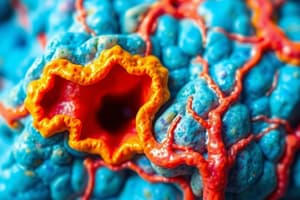Podcast
Questions and Answers
What is the primary function of epithelial tissue?
What is the primary function of epithelial tissue?
- To synthesize hormones
- To form the outer covering of the body (correct)
- To store reserve nutrients
- To provide support for the body
Which type of tissue consists of cells that are capable of stretching as they accommodate changes in the size of their surroundings?
Which type of tissue consists of cells that are capable of stretching as they accommodate changes in the size of their surroundings?
- Elastic tissue
- Connective tissue
- Pseudostratified columnar
- Transitional (correct)
Which connective tissue function involves synthesizing hormones?
Which connective tissue function involves synthesizing hormones?
- Binding various body parts together
- Synthesizing hormones (correct)
- Providing support and stability
- Recognizing and destroying foreign particles
What is a secondary function of epithelial tissue besides forming the outer covering of the body?
What is a secondary function of epithelial tissue besides forming the outer covering of the body?
In addition to providing support and playing a role in the immune system, what is another function of connective tissue?
In addition to providing support and playing a role in the immune system, what is another function of connective tissue?
Which type of tissue is responsible for forming the outer covering of organs in multicellular organisms?
Which type of tissue is responsible for forming the outer covering of organs in multicellular organisms?
Where are simple squamous epithelial cells commonly found in the body?
Where are simple squamous epithelial cells commonly found in the body?
What is the main function of connective tissue in the body?
What is the main function of connective tissue in the body?
Which type of epithelial tissue consists of multiple layers of cubical cells?
Which type of epithelial tissue consists of multiple layers of cubical cells?
In which body structures are you likely to find connective tissues?
In which body structures are you likely to find connective tissues?
Flashcards are hidden until you start studying
Study Notes
Tissues: Types, Functions, Epithelial, Connective
Tissues are groups of cells that work together to perform specific functions within organisms. There are four major types of tissues - epithelial, connective, muscular, and nervous. This article will focus on the first two: epithelial and connective tissue.
Types of Tissues
Epithelial Tissue
Epithelial tissue is the outer covering of all organs in multicellular organisms, forming a continuous layer over and inside surfaces, enclosing hollow tubes such as blood vessels, ducts, etc., and lining the cavities of body structures like the heart, lungs, kidneys, gastrointestinal tract, respiratory system, urinary system, reproductive systems and excretory systems. It forms a protective barrier, helping prevent invasion by foreign matter and separation and protection of internal organs and structures from the environment.
There are several types of epithelia:
- Simple squamous: thin and flat cells which form single layers with minimal intercellular materials between them. They are found in the lung alveoli, the inner lining of capillaries and venules, and the peritoneum and serous membranes around abdominal cavity organs.
- Stratified simple cuboidal: multiple layers of cubical cells that differentiate into various cell types.
- Transitional: consists of tall, cylindrical cells capable of stretching as they accommodate changes in the size of their surroundings, primarily found in the bladder, ureters, urethra, and parts of the alimentary canal.
- Pseudostratified columnar: contains goblet cells that secrete mucus to lubricate internal passages lined with this kind of epithelium.
Connective Tissue
Connective tissue binds other tissues together and provides support, allowing movement and growth of the animal's body parts and increases stability. It includes fatty tissue, muscle, reticular, elastic, cartilage, and bone.
Functions of Tissues
Epithelial Tissue Function
The primary function of epithelial tissue is to form the outer covering of the body and line the cavities in organs. Its secondary functions include secretion and absorption, protection against pathogens, sensation through touch, taste, vision, hearing, smell, temperature, and pain perception, and regulation of internal environment through osmoregulation.
Connective Tissue Function
Connective tissue supports other tissues and organs, provides protection, and binds various parts of the body together. It also stores reserve nutrients, synthesizes hormones, and plays a role in the immune system by recognizing and destroying foreign particles.
In summary, while epithelial tissue acts as a protective layer and contributes to various functions such as secretion and absorption, connective tissue provides support and stability, and plays a crucial role in the immune system. Both tissues are essential for the functioning and structure of multicellular organisms.
Studying That Suits You
Use AI to generate personalized quizzes and flashcards to suit your learning preferences.




